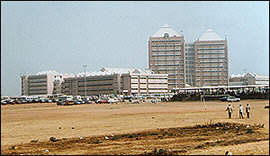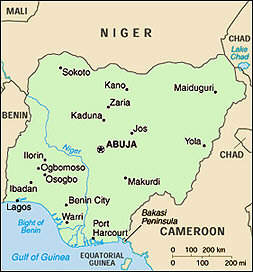 The Country The Country
 The Republic of Nigeria The Republic of Nigeria
According to Pedersen the Nigerian National and Merchant Flag and Jack was "Chosen in 1959 from among 2870 suggestions in a competition; it was designed by a student from Ibadan, Michael Taiwo Akinkunmi. The green panels represent agriculture; the white, peace and unity. The flag that was adopted in 1959 didn't become the official flag of the country until Nigeria became an official country on 1 October 1960.

 The Government The Government
After being ruled under military regime for four decades, Nigeria has finally become a democratic republic with the election of President Olusegun Obasanjo in May 1999.
The country is divided into 36 states, each with its own capital and state government, plus the Federal Capital Territory of Abuja. In 1991, the capital was moved from Lagos to Abuja. Traditional government in the States was administered through a system of local kings and chiefs. These traditional rulers still play a key rule in local government today. | 
 Geography Geography
Nigeria lies in West Africa six degrees north of the equator and occupying the south coast of Africa's great bulge, with the Atlantic Gulf of Guinea to the south. Four countries border it: Benin to the west, Niger to the north, Chad to the north-east and Cameroon to the east.
 Climate Climate
In the north, Nigeria is found to be hot and dry, with the rainy season being between April and September, while it is hot and wet in the South, with the rainy season running from March to November. A long dusty dry season stretches from December to March when the cooling harmattan blows off the desert. |

